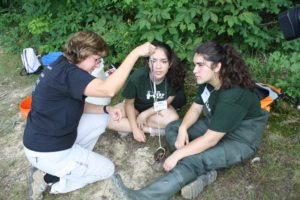Timely Turtle Teaching

To view the photo-rich magazine version, click here.
Originally appears in the Winter 2018 issue.
People are fascinated with freshwater turtles; they are such unusual creatures with their hard shells made up of ribs and vertebrae and they have such curious behaviors. These mostly benign animals (Snapping turtles can certainly seem threatening and they ferociously defend themselves if cornered or captured.) live mostly in the water, yet they must surface to breathe. How long can they rest? How long can they hibernate? What happens to turtles that live in really cold climates? (Some turtles freeze, but don’t die.) Freshwater aquatic turtles have been ubiquitous in wetland habitats all over the world, yet today they face many threats. In fact, they are the most threatened vertebrate in the world.
Turtles in many countries face the following problems: 1) harvest for the pet, medicine and food trades (Turtles are exported to mostly Asian countries, especially China.); 2) habitat loss, degradation and fragmentation (from deforestation, conversion to intensive agriculture, residential and commercial development, transmigration areas, and logging); 3) water pollution (siltation and pollutants from sewage, fertilizers, agriculture, and manufacturing); 4) competition from invasive turtle species (including releases from the pet trade); 5) road mortality; 6) disease; 7) drought; and 8) predators. In this paper, we focus specifically on turtle harvest and turtles as invasive species. The purpose of this article is to share our science/education work on turtles in the United States (North Carolina) and in Indonesia (Bengkulu, Sumatra), and to encourage others to teach about the plight that freshwater turtles face.
This content is restricted to subscribers only.
If you are not yet a subscriber, please consider taking out a subscription here.
If you are an existing subscriber, kindly log in or contact us at info@greenteacher.com for more information.





